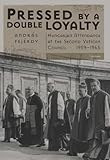Pressed by a Double Loyalty : Hungarian Attendance at the Second Vatican Council, 1959-1965 / András Fejérdy.
Material type: TextPublisher: Budapest ; New York : Central European University Press, [2022]Copyright date: ©2017Description: 1 online resource (446 p.)Content type:
TextPublisher: Budapest ; New York : Central European University Press, [2022]Copyright date: ©2017Description: 1 online resource (446 p.)Content type: - 9789633861431
- Church and state -- Hungary -- History -- 20th century
- Communism and Christianity -- Catholic Church
- Communism and Christianity -- Hungary
- Communism and Christianity--Hungary
- RELIGION / Christianity / Catholic
- Catholic Church, Cold War, Communism, Diplomacy, Foreign relations, Politics of religion, Vatican
- BX1542.3 .F4513 2016
- BX1542.3 .F4513 2016
- online - DeGruyter
| Item type | Current library | Call number | URL | Status | Notes | Barcode | |
|---|---|---|---|---|---|---|---|
 eBook
eBook
|
Biblioteca "Angelicum" Pont. Univ. S.Tommaso d'Aquino Nuvola online | online - DeGruyter (Browse shelf(Opens below)) | Online access | Not for loan (Accesso limitato) | Accesso per gli utenti autorizzati / Access for authorized users | (dgr)9789633861431 |
Frontmatter -- Table of contents -- Foreword -- Preface and acknowledgements -- List of Abbreviations -- Introduction -- Part I. The (Ante-) Preparatory Phase of the Council (1959–1962) -- Part II. Hungary and the Holy See during the Second Vatican Council (1962–1965) -- Part III. Epilogue: After the Council -- Summary -- Chronology -- Sources and Bibliography -- Index
restricted access online access with authorization star
http://purl.org/coar/access_right/c_16ec
The Second Vatican Council is the single most influential event in the 20th century history of the Catholic Church. The book analyzes the relationship between the Council and the "Ostpolitik" of the Vatican through the history of the Hungarian presence at Vatican II. Pope John XXIII, elected in 1958, was a catalyst. The pope thought that his most urgent task was to renew contacts with the Church behind the iron curtain. Hungarian participation at the Council was also made possible by the new, pragmatic model in Hungarian church politics. After the crushing of the 1956 Revolution, churches in Hungary thought that the regime would last and were willing to compromise. Vatican II – in the perspective of Hungary – was not primarily an ecclesial event, but it remained closely joined to the negotiations between the Holy See and the Kádár regime: during the Council Hungary became the experimental laboratory of the Vatican's new eastern policy. Was it a Vatican decision or a Soviet instruction? Fejérdy suggests that it was a decision of the Holy See.
Mode of access: Internet via World Wide Web.
In English.
Description based on online resource; title from PDF title page (publisher's Web site, viewed 30. Aug 2022)


